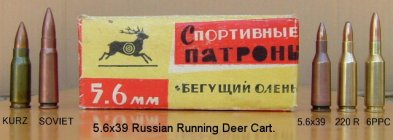There can’t be a benchrest shooter alive today who hasn’t heard of the 220 Russian. After all, his PPC brass carries that very headstamp. Todays shooters almost exclusively use Lapua 220 Russian brass but anyone who was around before the 1990s will also recognize the Sako 220 Russian cases. Sako brass is what Dr. Lou Palmisano used for his very first PPC case and most benchrest shooters adopting the round in the 1970s and 80s used it too.
But how many shooters have actually seen a 220 Russian cartridge? I don’t mean the brass made in Finland by Sako or Lapua, but a real 220 Russian made in Russia. Not too many, I’d say. And probably not many more know the story behind the origins of the 220 Russian.
You might say that the 220 Russian was inspired by a cartridge that was inspired by another cartridge. For the beginning we have to go all the way back to 1942. In that year of World War II the German army first tested its new 7.92x33mm Kurz cartridge in actual combat against the Russian army. A shortened 8mm Mauser cartridge, the Kurz and the MP43 “assault rifleâ€, or Sturmgewehr, caught everyone by surprise and the idea was quickly copied by the Russians themselves. By the war’s end they had developed their own version of the assault rifle, the SKS, and later the AK and AKM. All used a cartridge very similar to the Kurz, one that is still used today, the 7.62x39mm Soviet
During the Cold war there was very little exchange of information between the east and the west particularly when it came to weapons and ammunition. But we do know that by the late 1950s the Soviets had necked down the 7.62x39mm to 5.6mm ,actually .221 bullet diameter) and were using it in a steel cased cartridge for running deer competition. With Finland so near, and with the 7.62x39mm being the official Finnish military cartridge, it was no surprise that the 5.6x39mm cartridge was also manufactured and used in that country. Both Sako and Lapua began production of the 5.6x39mm brass cartridges around 1965 and when imported to the United States they were headstamped SAKO 220 RUSSIAN and LAPUA 5.6x39,later changed to LAPUA 220 RUSSIAN).
Pictured below are a 7.92x33mm Kurz, a 7.62x39mm Soviet, an original box of 5.6x39mm Russian ammunition, a steel-cased 5.6x39mm Russian cartridge, a brass cased Sako 220 Russian cartridge, and the descendant and end of the line for them all, a 6mm PPC.
But how many shooters have actually seen a 220 Russian cartridge? I don’t mean the brass made in Finland by Sako or Lapua, but a real 220 Russian made in Russia. Not too many, I’d say. And probably not many more know the story behind the origins of the 220 Russian.
You might say that the 220 Russian was inspired by a cartridge that was inspired by another cartridge. For the beginning we have to go all the way back to 1942. In that year of World War II the German army first tested its new 7.92x33mm Kurz cartridge in actual combat against the Russian army. A shortened 8mm Mauser cartridge, the Kurz and the MP43 “assault rifleâ€, or Sturmgewehr, caught everyone by surprise and the idea was quickly copied by the Russians themselves. By the war’s end they had developed their own version of the assault rifle, the SKS, and later the AK and AKM. All used a cartridge very similar to the Kurz, one that is still used today, the 7.62x39mm Soviet
During the Cold war there was very little exchange of information between the east and the west particularly when it came to weapons and ammunition. But we do know that by the late 1950s the Soviets had necked down the 7.62x39mm to 5.6mm ,actually .221 bullet diameter) and were using it in a steel cased cartridge for running deer competition. With Finland so near, and with the 7.62x39mm being the official Finnish military cartridge, it was no surprise that the 5.6x39mm cartridge was also manufactured and used in that country. Both Sako and Lapua began production of the 5.6x39mm brass cartridges around 1965 and when imported to the United States they were headstamped SAKO 220 RUSSIAN and LAPUA 5.6x39,later changed to LAPUA 220 RUSSIAN).
Pictured below are a 7.92x33mm Kurz, a 7.62x39mm Soviet, an original box of 5.6x39mm Russian ammunition, a steel-cased 5.6x39mm Russian cartridge, a brass cased Sako 220 Russian cartridge, and the descendant and end of the line for them all, a 6mm PPC.











